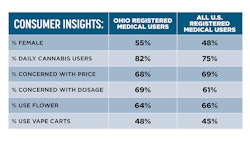
Cannabis Business Times Editorial Director Noelle Skodzinski, Associate Editor Tony Lange and Senior Digital Editor Melissa Schiller conducted interviews for and contributed to this article.
Editor's Note: This article was updated at 2:45 p.m. Nov. 7 to reflect market data released after this article was published from the Ohio Medical Marijuana Control Program.
Cannabis cultivation companies operating in Ohio’s medical market say they are cautiously optimistic about the likelihood voters will approve Issue 2, a statewide ballot initiative to legalize adult-use consumption and sales.
The statutory measure is a proposed law for the Ohio Revised Code that aims to: commercialize, regulate, legalize and tax the adult use of cannabis. If voters approve the citizen-led initiative, which needs a simple majority (50% plus one) to pass, Ohio lawmakers would be required to write legislation to enact the new law and have final say in the bill language. It’s not a constitutional amendment, so legislators can revise the proposal.
“All the public and private polling I have seen on the issue has never put support at less than 58%, but nothing is ever guaranteed in the world of cannabis,” said Geoff Korff, CEO of Galenas, a cultivation company based in Akron that also has operations in Michigan. “The political leadership in Columbus has come out universally against Issue 2. We have to stay absolutely focused on seeing this through to Election Day and not get complacent, and then stay focused after Election Day even if it passes, because I am certain there is going to be a push to gut it legislatively.”
Major state media outlets, including the editorial boards of The Plain Dealer/Cleveland.com and Crain’s Cleveland Business, are encouraging voters to approve Issue 2 Nov. 7 (or before if they are opting to get their ballots in early). Akron Beacon Journal’s editorial board is split.
“Legalizing recreational marijuana will make this market safer, better studied and with revenues benefiting oversight and research, not criminal enterprises,” wrote The Plain Dealer editorial board.
Despite Ohio being a “fairly conservative state,” Jeff McCourt, founder and CEO of Firelands Scientific, a vertically integrated medical cannabis company based in Ohio that operates five The Landing Dispensary locations in Ohio and five in West Virginia, said there seems to be broad support for sensible cannabis legalization. If approved, Ohio would join 23 other states that have already enacted adult-use legalization.
“You’ve got an issue that really is one of the few remaining ones in popular culture right now and in political culture that is a true bipartisan purple issue where you have people defying party logic or party lines in their support, or in some cases opposition, to cannabis,” McCourt says. “By and large, when you look at the time continuum of how long cannabis has been illegal and how it’s been treated historically to then the past 10 years in the evolution of the markets, it's been a really successful exercise of these laboratories of democracy. The different states, figuring out ways to legalize, normalize this product, regulate it, tax it to be effective for their state jurisdiction. So, we see that support in the general populace throughout Ohio.”
In 2015, an adult-use initiative appeared on the Ohio ballot and was defeated, with more than 63% voting no. However, the proposed constitutional amendment only allowed for 10 facilities “with exclusive commercial rights to grow marijuana” to operate in the state, and many cited the monopoly that would create as their central concern.
In October, a Baldwin Wallace University poll showed that Ohio voters are in favor of Issue 2: 57% said they plan to vote "yes" on Issue 2; majorities across most political and demographic groups support Issue 2, including 66% of Democrats, 50% of Republicans, 59% of independents, 70% of parents, and 71% of respondents ages 18-49. And nearly half of respondents 50 and older (47%) support Issue 2.
If passed, the law would automatically take effect in 30 days.
RELATED: Ohio 2023 Adult-Use Ballot Measure Fact Sheet
Currently the Ohio Department of Commerce and Board of Pharmacy co-regulate the medical program through the Medical Marijuana Control Program (MMCP). The two-agency structure has long been a challenge for operators. If Issue 2 is approved, the Division of Cannabis Control, which would be established under the Ohio Department of Commerce, would run the program.
Regulators would then have six months to engage in the rule making process to finalize, or begin the process to finalize, the administrative rules, says Tom Haren, spokesperson for the Coalition to Regulate Marijuana Like Alcohol, which led the effort to get Issue 2 on Ohio’s ballot.
“But they have to accept license applications for that first batch of adult-use licenses within six months, and then within nine months, they're supposed to issue the first round of adult-use licenses,” says Haren, who is also a partner and chair of the cannabis law practice at Frantz Ward. “So effectively what that could mean is that we could see the first adult-use sales of marijuana in Ohio before the end of next year.”
If approved, the proposed law would create 40 new level III cultivation licenses and 50 dispensary licenses in the adult-use program, which would be issued “with preference to applicants who are participants under the cannabis social equity and jobs program,” according to the proposed law’s language. After two years, regulators could add more licenses.
As of the latest program update Oct. 31, there are 37 cultivation companies currently operating in Ohio’s medical market and 111 active dispensaries licensed in the state, which has a population of nearly 12 million. Dispensaries that won provisional licenses as part of the MMCP’s most recent round of licensing are still rolling out, and soon there will be about 130 dispensaries in the state. Those already operating in the medical program could convert.
“But the reality is there are still so many barriers to entry for too many patients,” Haren says. “If you're a veteran suffering from PTSD and your VA doc can't issue a recommendation. Or you're a cancer patient treated by one of our major health systems who also prohibit their doctors from issuing recommendations. Or you're somebody who suffers from a condition like anxiety, which is a qualifying condition in other states, but our state medical board refuses to add anxiety to the list of qualifying conditions under our medical program for those patients.”
More than 182,000 people are active in Ohio’s medical program, including 23,000 patients with veteran status, according to the Ohio Medical Marijuana Control Program. There are 26 qualifying conditions that patients can register under. However, more than 369,500 unique patients have purchased products at dispensaries. The discrepancy in active versus historical numbers could be because of the barriers to entry, including having to have a specialized doctor provide a medical marijuana recommendation, which can cost $200 to $300, and the state’s yearly renewal requirement of $50. And even for those who do qualify, many in Ohio are well aware that people drive to Michigan, which launched adult-use sales in December 2018, rather than register as a patient in their home state.
“Clearly the medical program in Ohio was set up from the beginning with some major flaws, and so the reality is that we are not going to advance the cause of patients without an adult-use program in place. This sounds a bit counterintuitive, but it’s an unfortunate reality in our state,” Korff says. “The main thing patients in Ohio need is simply more access and fewer barriers. When it makes more sense for tens of thousands of people to drive to Michigan as opposed to staying home to purchase their medicine, you know you have a problem.”
Because of this and other limitations, operators say there is a surplus of product, which would allow growers and retailers to be more prepared for the inevitable surge in demand seen in other state programs when adult-use goes online.
While Andy Rayburn, CEO of vertically integrated cannabis company Buckeye Relief, says he is excited and optimistic about Election Day, there are some lingering concerns about what state legislators, who have openly opposed Issue 2, would do with the statute language.
“We want to win by as large a margin as possible because the next step after Election Day will be the Legislature trying to either appeal or change our initiated statute,” Rayburn says. “The bigger the margin of victory, the less legislators will be motivated to mess with something that passes by a popular vote.”
In interviews with media outlets, Ohio Gov. Mike DeWine has been outspoken against Issue 2, and the Ohio Senate passed a resolution Oct. 12 outlining their opposition.
Ohio Sen. Mark Romanchuk, one of the lawmakers who cosponsored the resolution, said legalizing cannabis for adult-use would add “fuel to the fire” to Ohio’s addiction crisis, “and we know from other states that have legalized marijuana use that traffic deaths, crime, and workplace accidents rise.”
These unsupported claims have been used by several opponents in the state to prevent voters from backing the initiative. Those against the measure also say that cannabis products would be easily accessible to minors if adult-use sales were permitted.
RELATED: Debunking 6 Claims About Ohio’s Cannabis Legalization Measure
“Here in Ohio, we have a successful medical marijuana program that has shown we know how to safely and reliably regulate the production and sale of marijuana products without the sky falling like we heard from the same prohibitionist crowd,” Haren says. “You know, they all said all these terrible things would happen six or seven years ago and none of them happened.”
McCourt echoed Haren’s sentiment and pointed out that although a future adult-use program in Ohio is often compared to neighboring Michigan, the actual market would be very different. Michigan has 729 active dispensaries in the state, according to the latest figures from Michigan’s Cannabis Regulatory Agency.
“We have a well-established, very tightly regulated medical program that's deployed in the market. It's not new, it's been running for five years,” McCourt says. “The legislation behind Issue 2 was developed after extensive review of all state adult-use programs in the country, adopting the successful attributes and learning from the mistakes other states have made. The most successful transitions from medical to adult-use sales has been in states that have a well-regulated medical market that is established and meeting patient needs. We have that in Ohio …. That strong foundation of our medical market gives us a huge leg up in transitioning to a broader market under adult-use.”
Preparing For the Inevitable Surge
With most polls showing support for Issue 2 and the likely quick launch of the program if voters approve establishing an adult-use cannabis market, businesses are preparing for the future increased demand now. The Ohio State University’s Drug Enforcement and Policy Center projected in August that a legalized market in Ohio would generate between $276 million and $403 million in annual tax revenue by the fifth year of commercial cannabis operations.
Rayburn of Buckeye Relief says the company is planning to expand its cultivation facility, which will allow for an additional 25,000 square feet of growing, processing and packaging space.
“It’ll expand every area of the company,” Rayburn says. “We've got those architectural drawings ready. We will not break ground on that until we see the firm timetable for the recreational market, and then we'll evaluate, and we'll decide, do we break ground sometime in ’24 or not?”
Buckeye Relief also operates two dispensaries under its Amplify brand, and a third location is slated to open in December.
“We built them and designed them to handle a significant increase in business in case of a future rec market, meaning they can easily handle two to three times the volume that they're doing right now, which will get us well into a rec market,” Rayburn says. “We do expect a rapidly expanded market overall from where we are now, which has been a relatively flat patient count for a year and a half with a significant increase in cultivation and processor supply. We're in a significantly oversupplied market right now. It’s not great for today's market, but it'll also make the transition to a recreational market smoother. ...”
McCourt said The Landing has established dispensaries in Cleveland, Columbus, Monroe and its recently opened Cincinnati location, which will allow them to pivot quickly if adult-use sales go online.
“Having such a broad retail footprint across all of the large metropolitan areas in Ohio gives us the best ability to learn from patients and customers directly and adapt our product offerings accordingly,” he said.
Amonica Davis, chief operating officer of Harvest of Ohio, which operates a cultivation facility and three dispensaries in the state, said that leaders have organized meetings and met with staff regularly to discuss how to prepare for the increase in customers.
“In addition, we plan to host a series of events to educate the community on the next steps after the passing of Issue 2, as well as provide education on the responsible use of marijuana,” Davis said.
McCourt says the Ohio Medical Cannabis Industry Association, a trade association he helped found, will be “working hand in hand” with industry partners and regulators to implement “a faithful adoption of the program at the rulemaking level,” ideally by fall 2024. He said he anticipates Ohio’s adult-use rollout will be smooth and successful because of the foundation of its medical market.
“We have a relatively low participation rate in the medical program. Illinois is maybe a good proxy state for a well-regulated, well-built, well-run medical program that converted effectively into an adult-use program that then has been on the other side, a really well-run, well-regulated and increasingly efficient in access points for patients on the adult-use side McCourt says. “So, we know that Ohio has been punching below its weight in the patient adoption rate under the medical program, which comes from a variety of things, but this wave of new dispensaries rolling out right now in the medical program is at minimum starting to finally serve patients where they are in the Ohio market.”
McCourt also said one of the strengths of Ohio’s adult-use proposal is the social equity initiatives. If approved, a cannabis social equity and jobs program would be established with 36% of the proceeds from the 10% excise tax (which is separate from a sales tax) used to finance the program. The proposed law also allocates tax revenues to supporting municipalities with dispensaries (36%), supporting education, substance abuse and addiction treatment programs (25%) and state costs to run the program (3%). In addition, licenses would be issued “with preference to applicants who are participants under the cannabis social equity and jobs program.”
“Sponsors were very vocal early on that we needed to have some prioritization of social equity licenses in this process, whether they have prior convictions for marijuana-related offenses or if they come from disadvantaged areas,” McCourt says. “We've got a whole swath of Eastern Southeastern Ohio that have really difficult economic outlooks and a lot of disadvantaged groups in that region that a lot of people don't think about when they think of social equity programs.”
Davis also noted the importance of the social equity initiative for allowing more access to ownership and eliminating the challenges for minorities and women to be able to establish thriving businesses.
“Issue 2 can create career opportunities for those who traditionally could not envision a point of access to the cannabis industry. Being a Black-owned business, it is vital that legislators move forward with the proposed social equity and jobs program so that this new industry is one that is diverse, inclusive and provides equitable opportunities to populations that would not otherwise be able to participate,” Davis noted. “Ohio’s 2016 medical marijuana law required 15% of all licenses to grow, process and sell marijuana be awarded to companies majority-owned and operated by a racial minority. The initial minority set aside program that was in place played a vital role in our CEO [Ariane Kirkpatrick] being selected to obtain the various licenses. Once we were awarded the license, the minority set aside was challenged and in November 2018 a Franklin County judge struck down the provision as it applied to cultivators and processors and found that there was no need for the set aside.”
Lingering Concerns
Although medical cannabis operators Cannabis Business Times interviewed were unanimous in their support for Issue 2, some raised concerns.
Although the proposed law would prohibit local government entities from restricting or limiting adult-use cannabis home grows, and restricting already established medical cultivation and processing facilities from converting to an adult-use market, municipalities can opt out of hosting standalone adult-use dispensaries, even those previously operating in the medical program. The existing dispensary could either continue to sell products under the medical program at its original location or move. Cities can also adopt ordinances and resolutions to prohibit or limit the number of adult-use cannabis operators permitted. Municipal opt-outs have been a challenge for other state-licensed retailers, including in California and Michigan, and a barrier for consumer access to tested and regulated cannabis products.
However, it wouldn't necessarily be easy. Dispensary owners who receive a license from the Division of Cannabis Control would be allowed to operate "unless a majority of the members of the legislative authority of a municipal corporation affirmatively pass an ordinance, or a majority of township trustees in a township affirmatively pass a resolution, after the license is issued and within one hundred and twenty days from license issuance, prohibiting the operation of the adult use dispensary within the municipal corporation or within the unincorporated territory of the township, respectively," according to the law's proposed language. Dispensaries could appeal the decisions and put the issue before voters, a process that is detailed in the proposed law.
Korff of Galenas said that while “there is much more to like than dislike in this statute,” he says one intended outcome could be a more consolidated market controlled by a dozen or so large operators. And he hopes that the social equity component—which has been a challenge and delayed New York’s program— is implemented effectively to ensure an illicit market doesn’t take hold.
“Social equity licensing is good and necessary, but every single state with a social equity program has botched the rollout. I am certainly concerned that if and when Issue 2 passes, that we will see further consolidation of the market … leaving all the other small businesses at a significant disadvantage,” he said. “That said, … we are putting our full support behind it. Regulated markets are always better than black markets for the consumer.”
Rayburn and McCourt both noted their concerns of unregulated, intoxicating hemp-derived products such as Delta-8 being widely available and increasingly problematic in the state. Often, those products, which do not have the same testing and compliance standards of products in state-regulated cannabis programs, are erroneously compared and can create confusion.
“I think that from a parent's perspective—I've got little kids—I have no concern about the regulated market and how thoroughly our products on the medical side, and then the carryover of that into the adult-use market, will be regulated, [including] advertising to children,” McCourt says. “All of those things are going to be prohibited in our market. But then you have basically an unregulated parallel market on the [Delta-8] side.
“I think that there's opportunities for improvements there.”
Rayburn says that is the next issue that operators hope to tackle, if, and he hopes when, adult-use legalization is a reality in Ohio.
“That’s the next area that our association is going to go after because already there's some 23 states that have taken legislative action against controlling the Delta-8 market in their states,” he says. “We know it's also completely untested product and in too many cases, it's unsafe product.”
Whatever happens next week, McCourt says the adult-use ballot initiative is a step in the right direction.
“The fact Issue 2 is on the ballot demonstrates that Ohioans are ready for the next stage of cannabis normalization,” McCourt says. “Pass or fail, the progress this demonstrates is undeniable and Firelands Scientific remains committed to our mission to uplift our patients and customers with high-quality, sustainably produced medicine.”
























